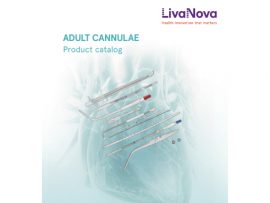Venoarterial extracorporeal membrane oxygenation (VA ECMO) provides temporary mechanical circulatory support for patients in refractory cardiogenic shock. Initiation of VA ECMO often results in increased left ventricular (LV) afterload as..
Read MoreAbstract Objective The use of an intra-aortic balloon pump (IABP) has been suggested to unload the left ventricle while on venoarterial extracorporeal membrane oxygenation (VA-ECMO) for cardiogenic shock (CS), leading..
Read MoreAbstract Background: Patients who undergo extracorporeal cardiopulmonary resuscitation (ECPR) are at risk of left ventricular distention and complications. There is emerging evidence that concurrent mechanical left ventricular (LV) unloading (e.g...
Read MoreAbstract Background Anterior myocardial infarction standard of care prioritizes swift coronary reperfusion. Recent studies show left ventricular (LV) unloading with transvalvular axial flow pumps for 30 minutes before reperfusion (vs..
Read MoreAbstract Background: Venoarterial extracorporeal membrane oxygenation (VA-ECMO) is increasingly used to treat cardiogenic shock. However, VA-ECMO might hamper myocardial recovery. The Impella unloads the left ventricle. This study aimed to..
Read MoreAbstract Background: Venoarterial Extracorporeal Membrane Oxygenation (VA-ECMO) is a means of supporting the lungs or the heart and lungs in patients with hemodynamic compromise that is refractory to conventional measures...
Read MoreAbstract Background Left ventricular unloading is needed in patients on extracorporeal life support (ECLS) with severely impaired left ventricular contractility to avoid stasis and pulmonary congestion, and to promote LV..
Read MoreAbstract Venoarterial extracorporeal membrane oxygenation (VA-ECMO) is applied for the treatment of cardiogenic shock. Concomitant left ventricular unloading (LVU) with a microaxial flow pump (mAFP) enables myocardial and pulmonary recovery..
Read MoreAbstract Purpose of Review To present an abridged overview of the literature and pathophysiological background of adjunct interventional left ventricular unloading strategies during veno-arterial extracorporeal membrane oxygenation (V-A ECMO). From..
Read MoreAbstract Purpose of review Discussing the rationale and current evidence for left ventricular unloading in cardiogenic shock. Recent findings Microaxial flow pumps (MFP) and intra-aortic balloon pumps (IABP) augment cardiac..
Read MoreAbstract The concept of left ventricular unloading has its foundation in heart physiology. In fact, the left ventricular mechanics and energetics represent the cornerstone of this approach. The novel sophisticated..
Read MoreAbstract Introduction Veno-arterial extracorporeal membrane oxygenation (V-A ECMO) improves end-organ perfusion in cardiogenic shock but may increase afterload, which can limit cardiac recovery. Left ventricular (LV) unloading strategies may aid..
Read MoreAbstract Venoarterial extracorporeal membrane oxygenation (VA-ECMO) shunts venous blood to the systemic arterial circulation to provide end-organ perfusion while increasing afterload that may impede left ventricle (LV) ejection and impair..
Read MoreAbstract Veno-arterial extracorporeal membrane oxygenation (VA-ECMO) is a powerful hemodynamic support strategy for patients with cardiogenic shock and out-of-hospital cardiac arrest (OHCA). Given that significant proportions of patients presenting with..
Read More










